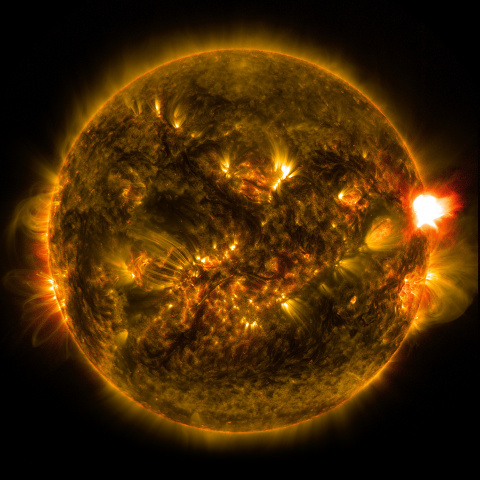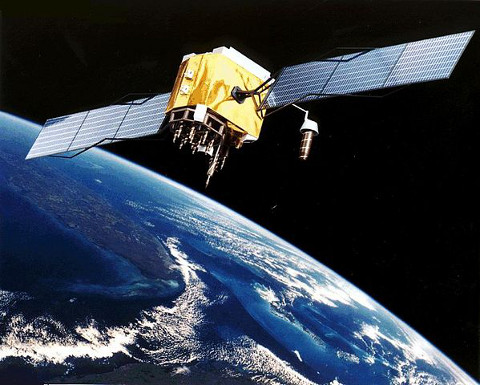 Beat The Bear
Beat The Bear Beat The Bear
Beat The Bear
 Our Sun is a hugely violent nuclear reaction. Occasionally there are massive bursts of solar material thrown off into space causing bursts of radiation and plumes of intensely hot gas which travel deep into the Solar System. Whether these 'Solar Flares' happen to affect our own planet is largely a matter of luck - if the flare intersects the Earth's orbit at the right time there can be significant effects either in the skies or on the ground. The results may be no more than bright Aurora or as much as widespread failure of electrical distribution systems.
Our Sun is a hugely violent nuclear reaction. Occasionally there are massive bursts of solar material thrown off into space causing bursts of radiation and plumes of intensely hot gas which travel deep into the Solar System. Whether these 'Solar Flares' happen to affect our own planet is largely a matter of luck - if the flare intersects the Earth's orbit at the right time there can be significant effects either in the skies or on the ground. The results may be no more than bright Aurora or as much as widespread failure of electrical distribution systems.
The solar storm of 1859[1] was named after the British astronomer who observed the storm on the sun's surface on September 1st, 1859. According to Wikipedia
On September 1-2, 1859, the largest known geomagnetic storm (as recorded by ground-based magnetometers) in modern times occurred. Auroras were seen around the world, those in the northern hemisphere as far south as the Caribbean; those over the Rocky Mountains in the U.S. were so bright that the glow woke gold miners, who began preparing breakfast because they thought it was morning. People in the northeastern United States could read a newspaper by the aurora's light. The aurora was visible as far from the poles as Sub-Saharan Africa (Senegal, Mauritania, perhaps Monrovia, Liberia), Monterrey and Tampico in Mexico, Queensland, Cuba, Hawaii and even at lower latitudes very close to the equator, such as in Colombia. Telegraph systems all over Europe and North America failed, in some cases giving telegraph operators electric shocks. Telegraph pylons threw sparks. Some telegraph operators could continue to send and receive messages despite having disconnected their power supplies.
Whilst the Aurora effects were probably the most visible of the impacts it's striking to read the accounts of the sparks and electrical impacts on telegraphy. 1859 predates any electrical distribution apparatus of any length installed in the industrial world apart from the long cross-country telegraph lines, the precursor of copper telephone wires (nowadays mostly replaced by glass fibres). When a solar storm intersects with the Earth's magnetic field, the effect on long lengths of wiring is to cause what we could loosely call 'power surges'.
More recently, although nothing of the magnitude of the 1859 storm has yet been recorded, a number of events of lesser size have been observed and some of these have caused large-scale power failures in the developed world. Electricity distribution systems are vulnerable and not easily protected against such storms and their wiring cannot be replaced with fibre.
Solar storms and other similar disturbances fall in the general category of "space weather". This subject has been widely studied and there are well-researched and authoritative reports available, listed below.
Whilst the Carrington event stands out as much larger than anything to happen since, the serious analysis suggests that the likelihood of something of similar scale occurring is approximately 150:1 in any given year (i.e. a one in 150 year probability) [2]. Alternative estimates for the probability can be found in a report from The Cambridge Centre for Risk Studies [3] which states Ultimately, a 100-year geomagnetic storm is identified as having a size greater than Carrington
i.e. roughly one such event per century.
A number of significant but fairly short-term effects are expected to be disruption to radio and satellite communications and air transport, the duration of the worst being a few days. More worrying is the potential for lengthy (weeks or months long) and widespread power shortages. Both of the these subjects will be discussed below.
Wikipedia provides a useful list of solar storms[4]. Also solarstorms.org lists numerous events in detail[5].
Significant storms in recent times include:
For those wishing to be alarmed you may wish to consider the event of 774-5[11] which may arguably have been a massive solar flare far exceeding the Carrington Event in size, which "had it happened in modern times, it may have produced catastrophic damage to modern technology, particularly to communication and space-borne navigation systems"[11] and also by implication, power distribution systems. The Royal Academy Report [2] suggests that it may have been 20 times as strong as the Carrington Event.
Modern life depends on technical infrastructure and systems which are particularly likely to be affected by solar weather. Short term effects lasting under a week are not of great significance to Beat The Bear but the reports listed at the bottom of the page address short-duration issues related to air and other transport systems which may be of interest to some readers. More important are the key infrastructure provided by satellites and power distribution which are considered individually here.
 Earth-orbiting satellites are exposed to a hostile environment and directly feel the effects of solar flares. Hardening them against the effects of radiation and space weather is a key aspect of satellite design and contributes directly to their costs both in terms of production and insurance. Designers have to make an trade-off between the costs of over-engineering the protection in light of the estimated risk and the expected lifetime of the satellite compared with the cost to the satellite operator of loss or degradation. The societal cost beyond that is unlikely to figure in the hard-nosed calculations of these multi-million dollar investments.
Earth-orbiting satellites are exposed to a hostile environment and directly feel the effects of solar flares. Hardening them against the effects of radiation and space weather is a key aspect of satellite design and contributes directly to their costs both in terms of production and insurance. Designers have to make an trade-off between the costs of over-engineering the protection in light of the estimated risk and the expected lifetime of the satellite compared with the cost to the satellite operator of loss or degradation. The societal cost beyond that is unlikely to figure in the hard-nosed calculations of these multi-million dollar investments.
Analysis suggests[2] that impact on the fleet of satellites in current use will range from short-term disruption with possibly degraded service life ranging through to loss, depending on the strength of the event that occurs. This is as would be expected, since we are literally dealing with 'rocket science' here and spacecraft designers are not fools. Even temporary loss of service can have consequences since satellites provide important infrastructure services. Excluding the 'trivial' loss of satellite broadcasting of entertainment we can list at least:
It seems reasonable to assume from the evidence available that, if there is more than a short-term loss of satellite services, the effects on the ground will be lasting and unpleasant. Spares and replacements are not items casually kept in warehouses somewhere and in case of an urgent need to rebuild the satellite fleet there will be huge constraints on production and launch capability, there is no tap that can just be turned on or off at will. Timescales here will be years not months.
Most trade around the world is carried by large container ships. In years gone by, mariners were obliged to navigate by the sun and stars using celestial navigation[12]. The author has experience of this and it's a specialised technique which is not easy to use. The advent of satellite navigation (GPS) revolutionised nautical navigation and it's highly likely that the modern merchant fleet would be very seriously inconvenienced if it had to revert to celestial navigation - coupled with some very spectacular mistakes when inexperienced navigators get it badly wrong. Even the US navy stopped teaching this technique to its officers before reintroducing[13] it upon realising the risk that reliance on GPS posed.
 The modern world is utterly dependent on electricity generated in large power stations and distributed by power grids to consumers. Grids necessarily require long lengths of wire to conduct the power and this is vulnerable to the electromagnetic disturbance caused by solar weather which distorts the earth's magnetic field (the magnetosphere).
The modern world is utterly dependent on electricity generated in large power stations and distributed by power grids to consumers. Grids necessarily require long lengths of wire to conduct the power and this is vulnerable to the electromagnetic disturbance caused by solar weather which distorts the earth's magnetic field (the magnetosphere).
The effects of solar storms on grids are not to overload them but rather to cause anomalous conditions which oblige the grid's protection systems to trigger. Non-technical readers may wish to skip the next paragraph of explanation.
Power grids are based largely around huge transformers which take the AC power and convert voltage and current. These are of course well-designed and operate within specification when presented with AC power. Geomagnetic disturbances can induce large DC energy flows and these can, in particular, cause core saturation in transformers which can be totally destructive in megawatt-scale transformers. This is viewed as an extremely significant risk in the serious studies of the subject [2][10]. The problem is well known in the industry and numerous mitigation steps are used but, to quote [2] in the UK Modelling indicates around six super
grid transformers in England and Wales and a further seven gridtransformers in Scotland could be damaged through geomagnetic
disturbances and taken out of service. The time to repair would be between weeks and months.
Damage to major transformers in grids should not be underestimated and is expected to occur during major solar storms [2] [10]. These are massive devices and whilst grid managers may have a few spares, even moving them to site is a large logistical exercise. They are extremely rare and specialised devices using highly specialised steel in their cores none of which is kept in inventory, or, in many parts of the world, even produced. It is easy to imagine that a worldwide shortage of these devices would take months or years to clear. Quoting [2] "The time for an emergency transformer replacement, when a spare is available, would normally be 8 to 16 weeks although the record is four weeks. A significant delay can be the time required to get permission to transport the spare transformer on the road, and in the event of a severe event it is hoped that priority would be given to allow transport to occur more rapidly".
To quote further from [2]
US space weather, transformer and modelling experts have recently produced conflicting reports analysing the impact on a large space weather event on the US system. In an influential report Kappenman [2010] suggests that a one-in-100-year event could lead to catastrophic system collapse in the US taking many years and trillions of dollars to restore. However, a comprehensive February 2012 report from the North American Electric Reliability Corporation [NERC, 2012], suggested that loss of reactive power and voltage instability would be the most likely outcomes.
Or to quote from [10]
A severe space weather event that causes major disruption to the electricity network in North America could have major implications for the insurance industry. As highlighted in this report, the total US population at risk of an extended outage from a Carrington-level storm ranges between 20-40 million with durations up to 1-2 years. The report also highlights that areas of high population concentrations, such as the corridor between Washington DC and New York City, could be at risk. The knock-on effects of loss of electricity are very difficult to quantify, but given the fact that our society is increasingly dependent on electricity they are likely to be severe and wide-ranging
This site steers clear of exaggeration but, should long-term and widespread power disruption occur in the advanced economies, this is one case where language like 'catastrophic' and 'disastrous' is warranted. The effects are (as we analyse elsewhere) very, very unpleasant to contemplate. Overall it seems fair to say that the overall view of the serious analysts is that a Carrington-level event would have survivable but unpleasant consequences.
It might be expected that more severe events would have correspondingly more severe implications for electricity distribution but this may not be the case. During private discussions with members of the panel on solar weather at the UCL IRDR 8th Annual Conference[14] it became clear that there is thought to be a limit to how much the earth's magnetosphere can be influenced - the analogy given was that "It's like ringing a bell. To some extent the harder you hit it the louder it gets but you can't make it infinitely loud". The UK is thought to be well-prepared for any realistic scenario though it was suggested that other regions may not be similarly ready.
We have not experienced an event as extreme as the Carrington Event since 1859. Nobody knows when the next event of that scale will occur. If the risk is a 1-in-150 year risk, that does not mean one every 150 years, as they are random. We could easily have one tomorrow, and the week after that also. A 1-in-2000 year event, (say) on the scale of the disputed 774 event could happen tomorrow too. We just don't know.
What is indisputably known is that these events have a known and unavoidable effect on some of the technological infrastructure that modern life depends on. The consensus of the the expert opinion appears to be that a Carrington event would probably be within manageable proportions and fall short of being a catastrophe, in so far as anyone can predict. A wise person or organisation is likely to want to have some mitigation strategies up their sleeve however.
All bets appear to be off if we get something that reaches the one-in-a-millenium scale of event. If the 774 event was a solar flare (it can only be guessed at from measuring proxies like Carbon-14 levels) all we can say is that it didn't seem greatly to perturb life in the Dark Ages. The Anglo-Saxon Chronicle reports [15]:
Annus Domini 774. This year the Northumbrians banished their king, Alred, from York at Easter-tide; and chose Ethelred, the son of Mull, for their lord, who reigned four winters. This year also appeared in the heavens a red crucifix, after sunset; the Mercians and the men of Kent fought at Otford; and wonderful serpents were seen in the land of the South-Saxons.
It seems reasonable to assume that a very large event would cause severe disruption to satellite communications, possibly even complete destruction. Electricity grids may be degraded in parts of the world depending on their preparedness since it's a well known risk factor and in the developed world mitigation strategies are in place.
A short internet search will produce numerous results relating to space weather written for various audiences. Three detailed analyses stand out and and are essential (though lengthy) reading:
Interested readers are likely to find the above three documents to be the source of most other reporting and analysis.
More digestible content for casual readers can be found amongst these examples, though the supply is endless: